Page 502 of 588
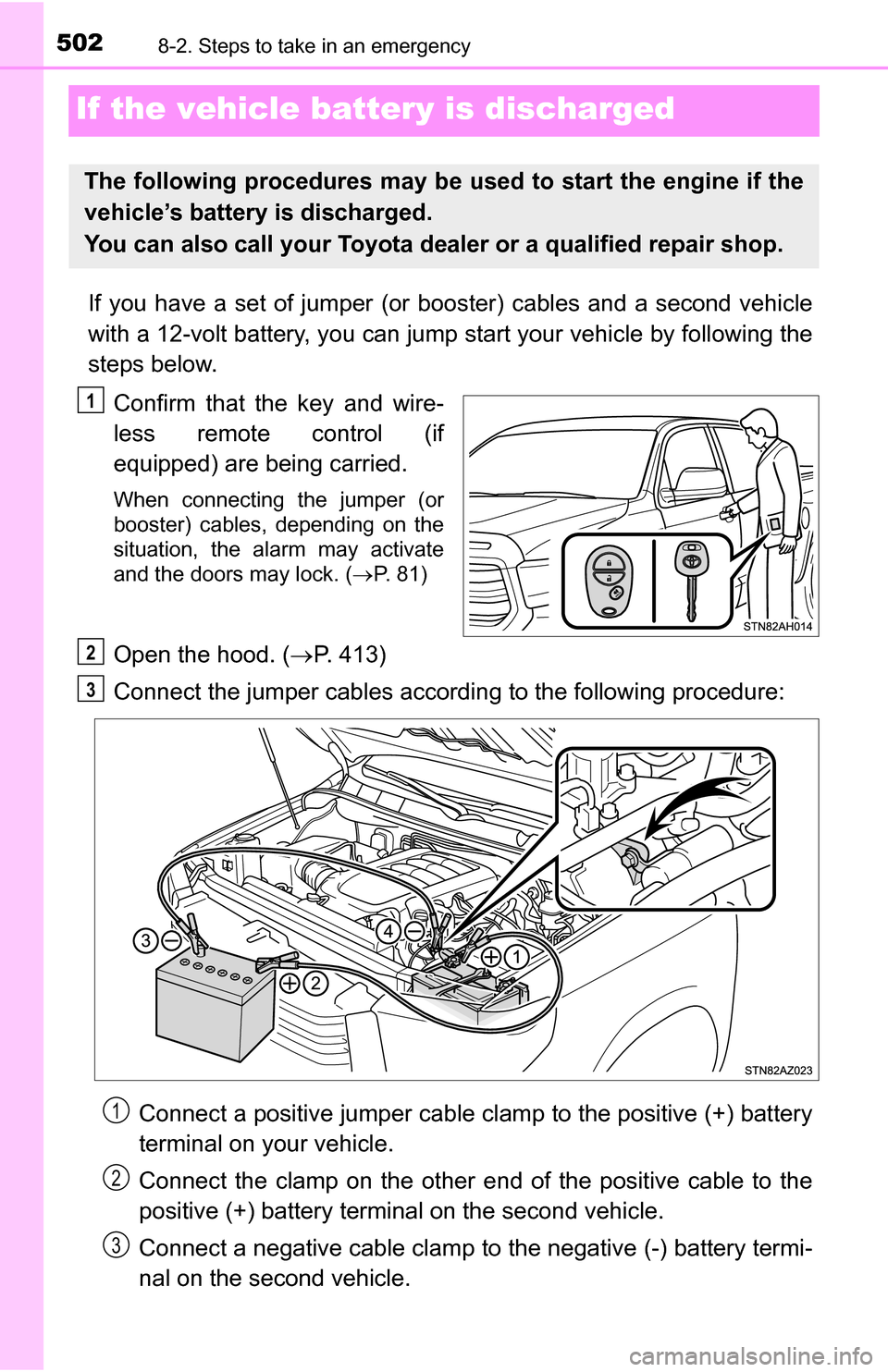
5028-2. Steps to take in an emergency
If the vehicle battery is discharged
If you have a set of jumper (or booster) cables and a second vehicle
with a 12-volt battery, you can jump start your vehicle by following the
steps below.
Confirm that the key and wire-
less remote control (if
equipped) are being carried.
When connecting the jumper (or
booster) cables, depending on the
situation, the alarm may activate
and the doors may lock. ( P. 81)
Open the hood. (P. 413)
Connect the jumper cables according to the following procedure:
Connect a positive jumper cable clamp to the positive (+) battery
terminal on your vehicle.
Connect the clamp on the other e nd of the positive cable to the
positive (+) battery terminal on the second vehicle.
Connect a negative cable clamp to the negative (-) battery termi-
nal on the second vehicle.
The following procedures may be used to start the engine if the
vehicle’s battery is discharged.
You can also call your Toyota de aler or a qualified repair shop.
1
2
3
1
2
3
Page 503 of 588
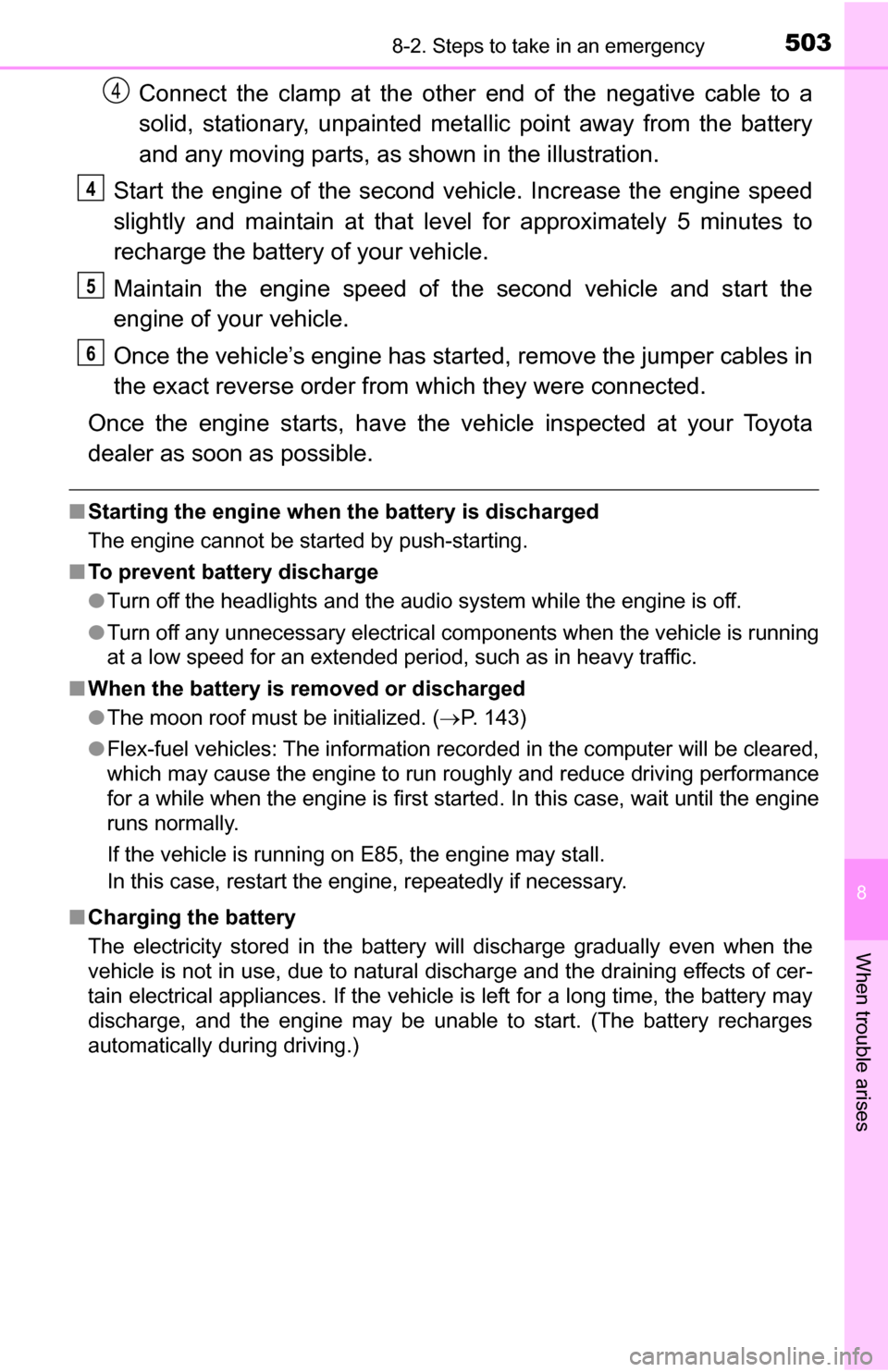
5038-2. Steps to take in an emergency
8
When trouble arises
Connect the clamp at the other end of the negative cable to a
solid, stationary, unpainted metallic point away from the battery
and any moving parts, as shown in the illustration.
Start the engine of the second v ehicle. Increase the engine speed
slightly and maintain at that level for approximately 5 minutes to
recharge the batter y of your vehicle.
Maintain the engine speed of t he second vehicle and start the
engine of your vehicle.
Once the vehicle’s engine has star ted, remove the jumper cables in
the exact reverse order from which they were connected.
Once the engine starts, have the v ehicle inspected at your Toyota
dealer as soon as possible.
■ Starting the engine when the battery is discharged
The engine cannot be started by push-starting.
■ To prevent battery discharge
●Turn off the headlights and the audio system while the engine is off.
● Turn off any unnecessary electrical components when the vehicle is running
at a low speed for an extended period, such as in heavy traffic.
■ When the battery is removed or discharged
●The moon roof must be initialized. ( P. 143)
● Flex-fuel vehicles: The information recorded in the computer will be cleared,
which may cause the engine to run roughly and reduce driving performance
for a while when the engine is first started. In this case, wait until the engine
runs normally.
If the vehicle is running on E85, the engine may stall.
In this case, restart the engine, repeatedly if necessary.
■ Charging the battery
The electricity stored in the battery will discharge gradually even when the
vehicle is not in use, due to natural discharge and the draining effects of cer-
tain electrical appliances. If the vehicle is left for a long time, the battery may
discharge, and the engine may be unable to start. (The battery recharges
automatically during driving.)
4
4
5
6
Page 505 of 588
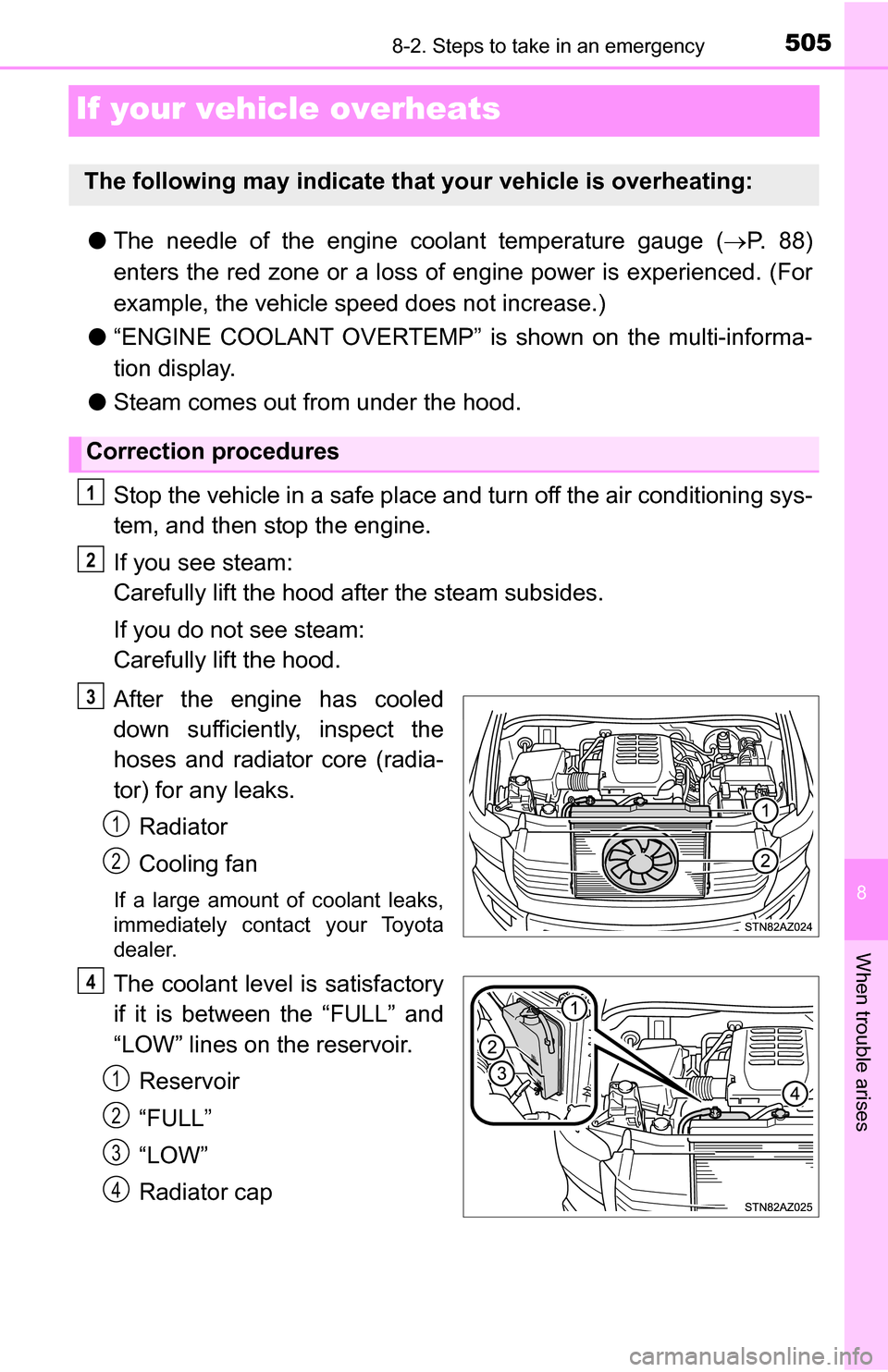
505
8
When trouble arises
8-2. Steps to take in an emergency
If your vehicle overheats
●The needle of the engine coolant temperature gauge ( P. 8 8 )
enters the red zone or a loss of engine power is experienced. (For
example, the vehicle sp eed does not increase.)
● “ENGINE COOLANT OVERTEMP” is shown on the multi-informa-
tion display.
● Steam comes out from under the hood.
Stop the vehicle in a safe place and turn off the air conditioning sys-
tem, and then stop the engine.
If you see steam:
Carefully lift the hood after the steam subsides.
If you do not see steam:
Carefully lift the hood.
After the engine has cooled
down sufficient ly, inspect the
hoses and radiator core (radia-
tor) for any leaks.
Radiator
Cooling fan
If a large amount of coolant leaks,
immediately contact your Toyota
dealer.
The coolant level is satisfactory
if it is between the “FULL” and
“LOW” lines on the reservoir.Reservoir
“FULL”
“LOW”
Radiator cap
The following may indicate that your vehicle is overheating:
Correction procedures
1
2
3
1
2
4
1
2
3
4
Page 506 of 588
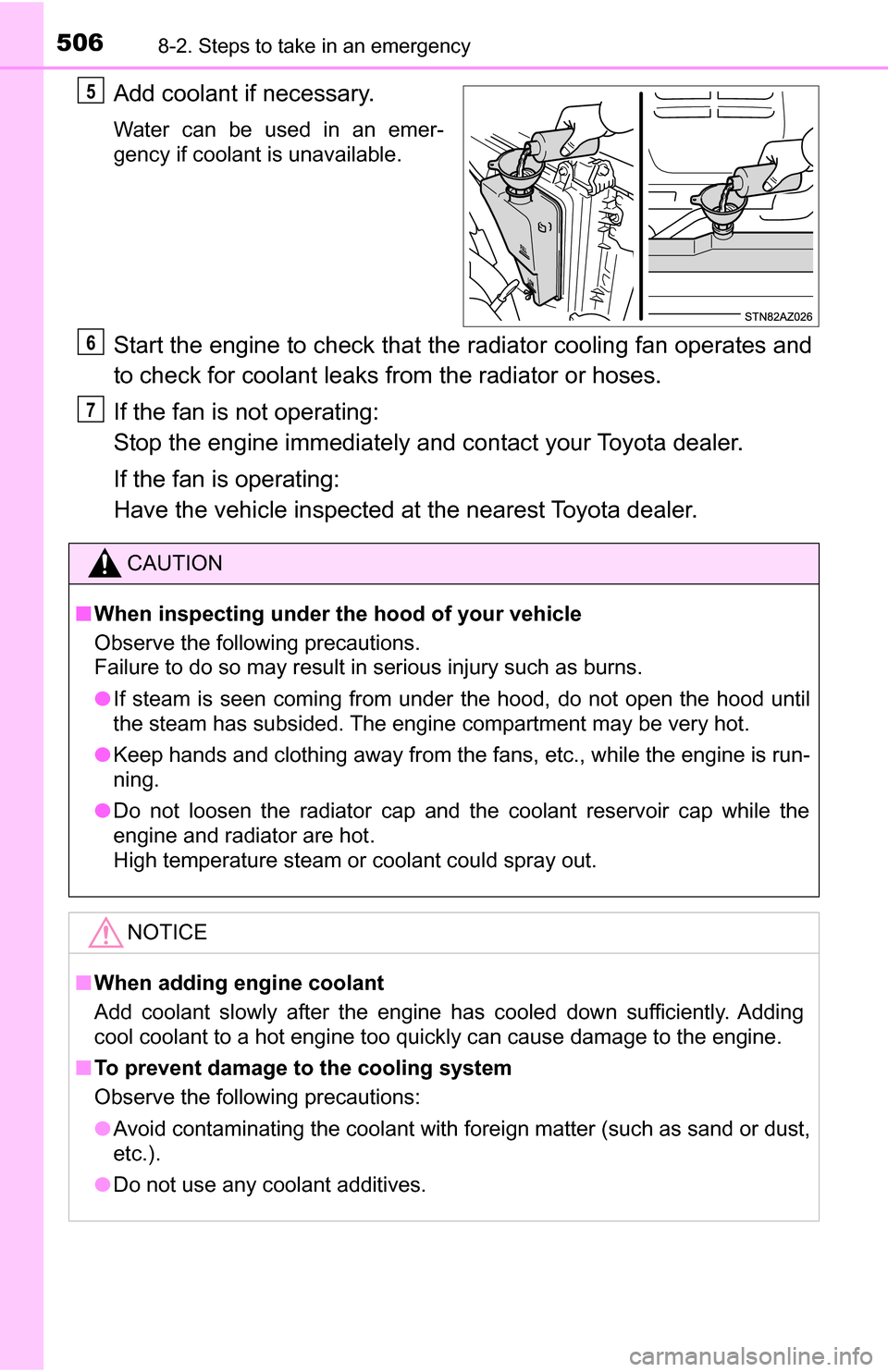
5068-2. Steps to take in an emergency
Add coolant if necessary.
Water can be used in an emer-
gency if coolant is unavailable.
Start the engine to check that the radiator cooling fan operates and
to check for coolant leaks from the radiator or hoses.
If the fan is not operating:
Stop the engine immediately and contact your Toyota dealer.
If the fan is operating:
Have the vehicle inspected at the nearest Toyota dealer.
5
CAUTION
■When inspecting under the hood of your vehicle
Observe the following precautions.
Failure to do so may result in serious injury such as burns.
● If steam is seen coming from under the hood, do not open the hood until
the steam has subsided. The engine compartment may be very hot.
● Keep hands and clothing away from the fans, etc., while the engine is run-
ning.
● Do not loosen the radiator cap and the coolant reservoir cap while the
engine and radiator are hot.
High temperature steam or coolant could spray out.
NOTICE
■When adding engine coolant
Add coolant slowly after the engine has cooled down sufficiently. Adding
cool coolant to a hot engine too quickly can cause damage to the engine.
■ To prevent damage to the cooling system
Observe the following precautions:
● Avoid contaminating the coolant with foreign matter (such as sand or dust,
etc.).
● Do not use any coolant additives.
6
7
Page 507 of 588
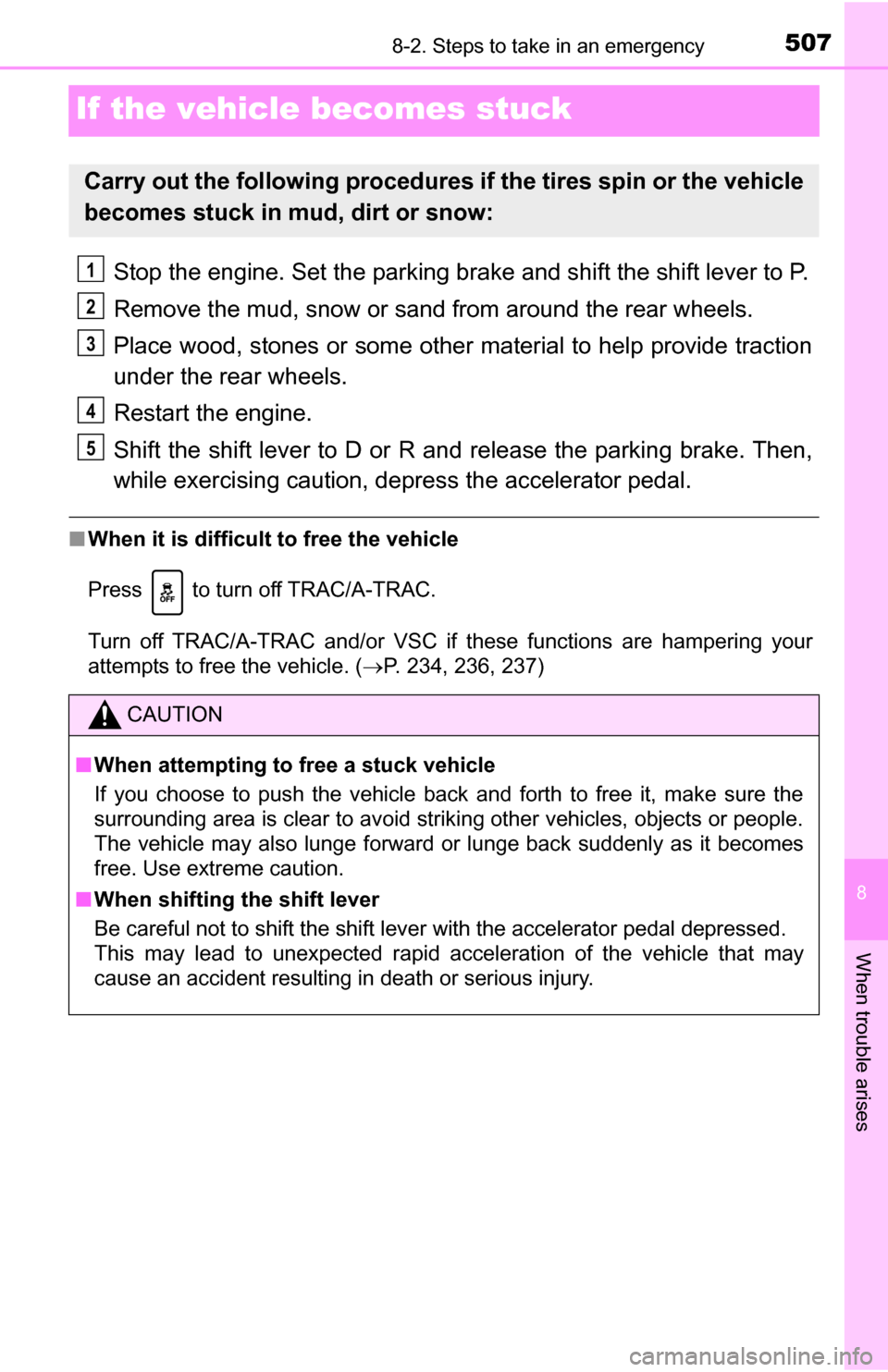
507
8
When trouble arises
8-2. Steps to take in an emergency
If the vehicle becomes stuck
Stop the engine. Set the parking brake and shift the shift lever to P.
Remove the mud, snow or sand from around the rear wheels.
Place wood, stones or some other material to help provide traction
under the rear wheels.
Restart the engine.
Shift the shift lever to D or R and release the parking brake. Then,
while exercising caution, depress the accelerator pedal.
■When it is difficult to free the vehicle
Press to turn off TRAC/A-TRAC.
Turn off TRAC/A-TRAC and/or VSC if these functions are hampering your
attempts to free the vehicle. ( P. 234, 236, 237)
Carry out the following procedures if the tires spin or the vehicle
becomes stuck in mud, dirt or snow:
CAUTION
■When attempting to free a stuck vehicle
If you choose to push the vehicle back and forth to free it, make sure the
surrounding area is clear to avoid striking other vehicles, objects or people.
The vehicle may also lunge forward or lunge back suddenly as it becomes
free. Use extreme caution.
■ When shifting the shift lever
Be careful not to shift the shift lever with the accelerator pedal depressed.
This may lead to unexpected rapid acceleration of the vehicle that may
cause an accident resulting in death or serious injury.
1
2
3
4
5
Page 512 of 588
5129-1. Specifications
Regular Cab models
*1: The model code is indicated on the Certification Label. (P. 519)
*2: Vehicles with towing package
*3: Vehicles with towing package and large fuel tank
*4: Vehicles without option
Vehicle capacity weight
Model code*1EngineDriving
systemBed type
Vehicle capacity weight
(Occupants + luggage)
USK51L-THTSKA 3UR-FE
engine
2WD
Long
1965 lb. (890 kg)
1890 lb. (855 kg)*2
1770 lb. (800 kg)*3
2035 lb. (920 kg)*4
USK51L-THTSGA 3UR-FBE
engine
1965 lb. (890 kg)
1890 lb. (855 kg)*2
1770 lb. (800 kg)*3
2035 lb. (920 kg)*4
USK56L-THTSKA 3UR-FE
engine
4WD
1905 lb. (860 kg)
1830 lb. (830 kg)*2
1710 lb. (775 kg)*3
USK56L-THTSGA 3UR-FBE
engine
1905 lb. (860 kg)
1830 lb. (830 kg)*2
1710 lb. (775 kg)*3
Page 513 of 588
5139-1. Specifications
9
Vehicle specifications
Double Cab models
Model code*1EngineDriving
systemBed type
Vehicle capacity weight
(Occupants + luggage)
UPK51L-CRTSKA 1UR-FE
engine 2WD
Standard
1405 lb. (635 kg)
UPK56L-CRTSKA 4WD
1315 lb. (595 kg)
USK51L-CRTSKA 3UR-FE engine
2WD
1590 lb. (720 kg)
1515 lb. (685 kg)*2
1390 lb. (630 kg)*3
USK51L-CRTLKA
1560 lb. (705 kg)
1485 lb. (670 kg)*2
1365 lb. (615 kg)*3
USK51L-CRTSGA 3UR-FBE engine
1590 lb. (720 kg)
1515 lb. (685 kg)*2
1390 lb. (630 kg)*3
USK51L-CRTLGA
1560 lb. (705 kg)
1485 lb. (670 kg)*2
1365 lb. (615 kg)*3
USK52L-CHTSKA 3UR-FE
engine
Long
1560 lb. (705 kg)
1485 lb. (670 kg)*2
1365 lb. (615 kg)*3
USK52L-CHTSGA3UR-FBE
engine
1560 lb. (705 kg)
1485 lb. (670 kg)*2
1365 lb. (615 kg)*3
USK56L-CRTSKA
3UR-FE engine 4WD Standard
1495 lb. (675 kg)
1425 lb. (645 kg)*2
1300 lb. (585 kg)*3
USK56L-CRTLKA
1490 lb. (675 kg)
1415 lb. (640 kg)*2
1295 lb. (585 kg)*3
Page 514 of 588
5149-1. Specifications
*1: The model code is indicated on the Certification Label. (P. 519)
*2: Vehicles with towing package
*3: Vehicles with towing package and large fuel tank
Model code*1EngineDriving
systemBed type
Vehicle capacity
weight
(Occupants + luggage)
USK57L-CHTSKA 3UR-FE
engine
4WDLong
1475 lb. (665 kg)
1405 lb. (635 kg)*2
1280 lb. (580 kg)*3
USK56L-CRTSGA
3UR-FBE engine Standard
1495 lb. (675 kg)
1425 lb. (645 kg)*2
1300 lb. (585 kg)*3
USK56L-CRTLGA
1490 lb. (675 kg)
1415 lb. (640 kg)*2
1295 lb. (585 kg)*3
USK57L-CHTSGA
Long
1475 lb. (665 kg)
1405 lb. (635 kg)*2
1280 lb. (580 kg)*3